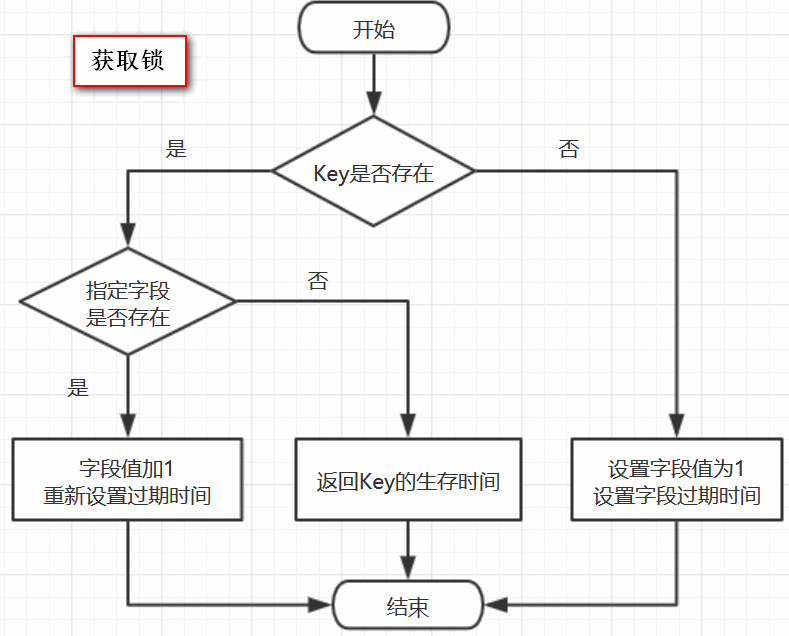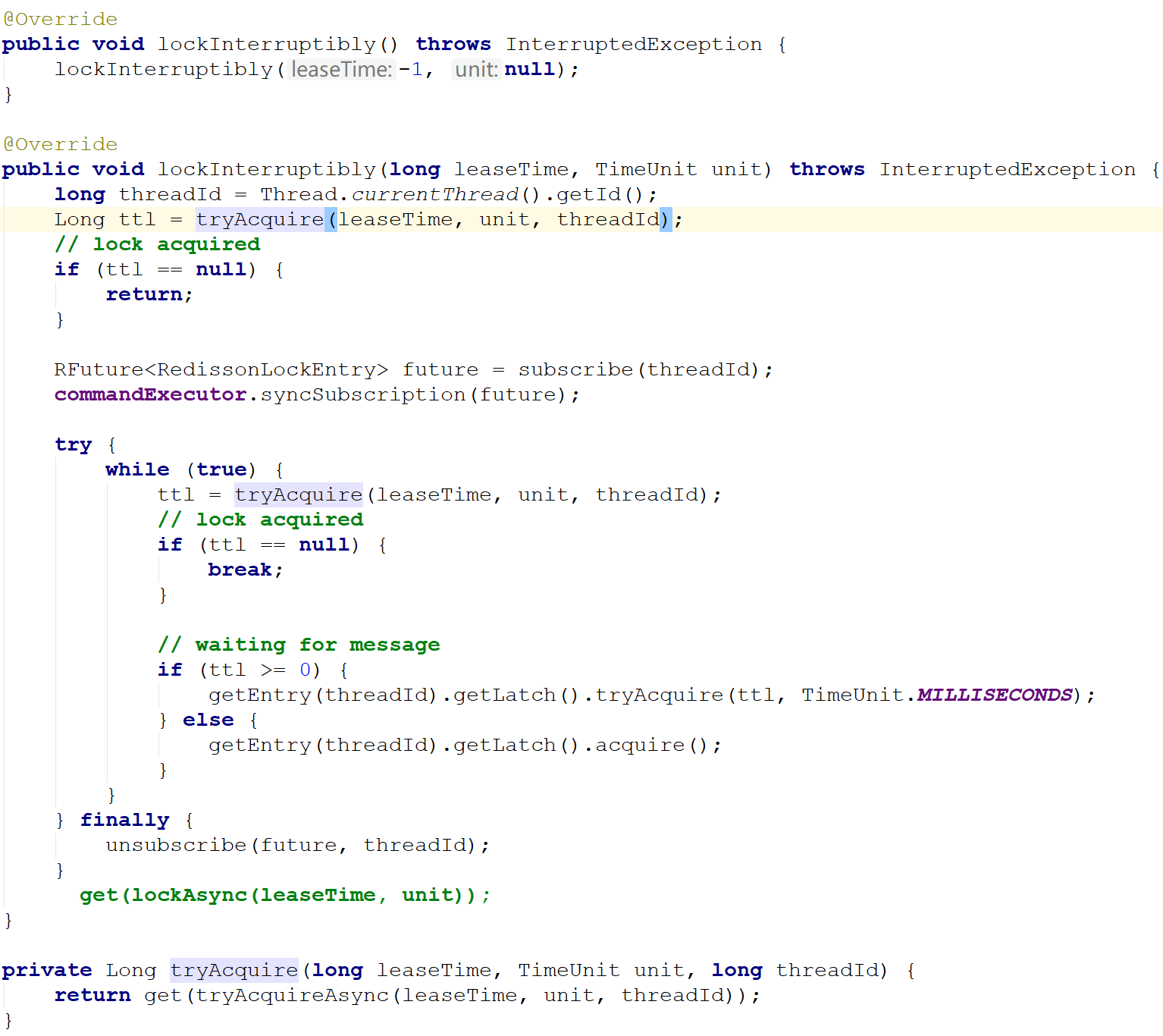1. 基本用法
<dependency> <groupId>org.redisson</groupId> <artifactId>redisson</artifactId> <version>3.8.2</version> </dependency>
Config config = new Config(); config.useClusterServers() .setScanInterval(2000) // cluster state scan interval in milliseconds .addNodeAddress("redis://127.0.0.1:7000", "redis://127.0.0.1:7001") .addNodeAddress("redis://127.0.0.1:7002"); RedissonClient redisson = Redisson.create(config); RLock lock = redisson.getLock("anyLock"); lock.lock(); try { ... } finally { lock.unlock(); }
针对上面这段代码,重点看一下Redisson是如何基于Redis实现分布式锁的
Redisson中提供的加锁的方法有很多,但大致类似,此处只看lock()方法
更多请参见 https://github.com/redisson/redisson/wiki/8.-distributed-locks-and-synchronizers
2. 加锁
可以看到,调用getLock()方法后实际返回一个RedissonLock对象,在RedissonLock对象的lock()方法主要调用tryAcquire()方法
由于leaseTime == -1,于是走tryLockInnerAsync()方法,这个方法才是关键
首先,看一下evalWriteAsync方法的定义
<T, R> RFuture<R> evalWriteAsync(String key, Codec codec, RedisCommand<T> evalCommandType, String script, List<Object> keys, Object ... params);
最后两个参数分别是keys和params
实际调用是这样的:
单独将调用的那一段摘出来看
commandExecutor.evalWriteAsync(getName(), LongCodec.INSTANCE, command, "if (redis.call('exists', KEYS[1]) == 0) then " + "redis.call('hset', KEYS[1], ARGV[2], 1); " + "redis.call('pexpire', KEYS[1], ARGV[1]); " + "return nil; " + "end; " + "if (redis.call('hexists', KEYS[1], ARGV[2]) == 1) then " + "redis.call('hincrby', KEYS[1], ARGV[2], 1); " + "redis.call('pexpire', KEYS[1], ARGV[1]); " + "return nil; " + "end; " + "return redis.call('pttl', KEYS[1]);", Collections.<Object>singletonList(getName()), internalLockLeaseTime, getLockName(threadId));
结合上面的参数声明,我们可以知道,这里KEYS[1]就是getName(),ARGV[2]是getLockName(threadId)
假设前面获取锁时传的name是“abc”,假设调用的线程ID是Thread-1,假设成员变量UUID类型的id是6f0829ed-bfd3-4e6f-bba3-6f3d66cd176c
那么KEYS[1]=abc,ARGV[2]=6f0829ed-bfd3-4e6f-bba3-6f3d66cd176c:Thread-1
因此,这段脚本的意思是
1、判断有没有一个叫“abc”的key
2、如果没有,则在其下设置一个字段为“6f0829ed-bfd3-4e6f-bba3-6f3d66cd176c:Thread-1”,值为“1”的键值对 ,并设置它的过期时间
3、如果存在,则进一步判断“6f0829ed-bfd3-4e6f-bba3-6f3d66cd176c:Thread-1”是否存在,若存在,则其值加1,并重新设置过期时间
4、返回“abc”的生存时间(毫秒)
这里用的数据结构是hash,hash的结构是: key 字段1 值1 字段2 值2 。。。
用在锁这个场景下,key就表示锁的名称,也可以理解为临界资源,字段就表示当前获得锁的线程
所有竞争这把锁的线程都要判断在这个key下有没有自己线程的字段,如果没有则不能获得锁,如果有,则相当于重入,字段值加1(次数)
3. 解锁
protected RFuture<Boolean> unlockInnerAsync(long threadId) { return commandExecutor.evalWriteAsync(getName(), LongCodec.INSTANCE, RedisCommands.EVAL_BOOLEAN, "if (redis.call('exists', KEYS[1]) == 0) then " + "redis.call('publish', KEYS[2], ARGV[1]); " + "return 1; " + "end;" + "if (redis.call('hexists', KEYS[1], ARGV[3]) == 0) then " + "return nil;" + "end; " + "local counter = redis.call('hincrby', KEYS[1], ARGV[3], -1); " + "if (counter > 0) then " + "redis.call('pexpire', KEYS[1], ARGV[2]); " + "return 0; " + "else " + "redis.call('del', KEYS[1]); " + "redis.call('publish', KEYS[2], ARGV[1]); " + "return 1; "+ "end; " + "return nil;", Arrays.<Object>asList(getName(), getChannelName()), LockPubSub.unlockMessage, internalLockLeaseTime, getLockName(threadId)); }
我们还是假设name=abc,假设线程ID是Thread-1
同理,我们可以知道
KEYS[1]是getName(),即KEYS[1]=abc
KEYS[2]是getChannelName(),即KEYS[2]=redisson_lock__channel:{abc}
ARGV[1]是LockPubSub.unlockMessage,即ARGV[1]=0
ARGV[2]是生存时间
ARGV[3]是getLockName(threadId),即ARGV[3]=6f0829ed-bfd3-4e6f-bba3-6f3d66cd176c:Thread-1
因此,上面脚本的意思是:
1、判断是否存在一个叫“abc”的key
2、如果不存在,向Channel中广播一条消息,广播的内容是0,并返回1
3、如果存在,进一步判断字段6f0829ed-bfd3-4e6f-bba3-6f3d66cd176c:Thread-1是否存在
4、若字段不存在,返回空,若字段存在,则字段值减1
5、若减完以后,字段值仍大于0,则返回0
6、减完后,若字段值小于或等于0,则广播一条消息,广播内容是0,并返回1;
可以猜测,广播0表示资源可用,即通知那些等待获取锁的线程现在可以获得锁了
4. 等待
以上是正常情况下获取到锁的情况,那么当无法立即获取到锁的时候怎么办呢?
再回到前面获取锁的位置
@Override public void lockInterruptibly(long leaseTime, TimeUnit unit) throws InterruptedException { long threadId = Thread.currentThread().getId(); Long ttl = tryAcquire(leaseTime, unit, threadId); // lock acquired if (ttl == null) { return; } // 订阅 RFuture<RedissonLockEntry> future = subscribe(threadId); commandExecutor.syncSubscription(future); try { while (true) { ttl = tryAcquire(leaseTime, unit, threadId); // lock acquired if (ttl == null) { break; } // waiting for message if (ttl >= 0) { getEntry(threadId).getLatch().tryAcquire(ttl, TimeUnit.MILLISECONDS); } else { getEntry(threadId).getLatch().acquire(); } } } finally { unsubscribe(future, threadId); } // get(lockAsync(leaseTime, unit)); } protected static final LockPubSub PUBSUB = new LockPubSub(); protected RFuture<RedissonLockEntry> subscribe(long threadId) { return PUBSUB.subscribe(getEntryName(), getChannelName(), commandExecutor.getConnectionManager().getSubscribeService()); } protected void unsubscribe(RFuture<RedissonLockEntry> future, long threadId) { PUBSUB.unsubscribe(future.getNow(), getEntryName(), getChannelName(), commandExecutor.getConnectionManager().getSubscribeService()); }
这里会订阅Channel,当资源可用时可以及时知道,并抢占,防止无效的轮询而浪费资源
当资源可用用的时候,循环去尝试获取锁,由于多个线程同时去竞争资源,所以这里用了信号量,对于同一个资源只允许一个线程获得锁,其它的线程阻塞
5. 小结


6. 其它相关



